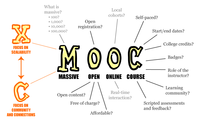
Photo from wikipedia
Blended learning has become increasingly common in higher education. Recent findings suggest that blended learning achieves better student outcomes than traditional face‐to‐face teaching in gross anatomy courses. While face‐to‐face content… Click to show full abstract
Blended learning has become increasingly common in higher education. Recent findings suggest that blended learning achieves better student outcomes than traditional face‐to‐face teaching in gross anatomy courses. While face‐to‐face content is perceived as important to learning there is less evidence for the significance of online content in improving student outcomes. Students enrolled in a second‐year anatomy course from the physiotherapy (PT), exercise physiology (EP), and exercise science (ES) programs across two campuses were included (n = 500). A structural equation model was used to evaluate the relationship of prior student ability (represented by grade in prerequisite anatomy course) and final course grade and whether the relationship was mediated by program, campus or engagement with the online elements of the learning management system (LMS; proportion of documents and video segments viewed and number of interactions with discussion forums). PT students obtained higher grades and were more likely to engage with online course materials than EP and ES students. Prerequisite grade made a direct contribution to course final grade (P < 0.001) but was also mediated by engagement with LMS videos and discussion forums (P < 0.001). Student learning outcomes in a blended anatomy course can be predicted the by level of engagement with online content. Anat Sci Educ 11: 471–477. © 2017 American Association of Anatomists.
Journal Title: Anatomical Sciences Education
Year Published: 2018
Link to full text (if available)
Share on Social Media: Sign Up to like & get
recommendations!